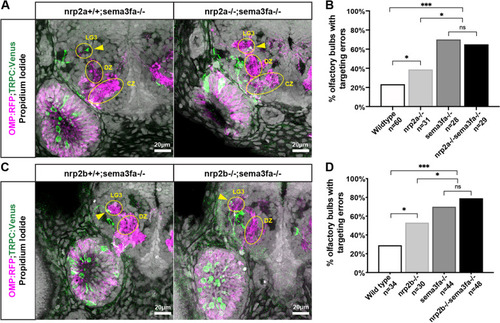Fig. 6
- ID
- ZDB-FIG-220131-161
- Publication
- Cheng et al., 2022 - Loss of Neuropilin2a/b or Sema3fa alters olfactory sensory axon dynamics and protoglomerular targeting
- Other Figures
- All Figure Page
- Back to All Figure Page
|
Misprojecting growth cones fail to retract in nrp2a and in sema3fa mutants. A. Live imaging sequences of nrp2a heterozygote and mutant siblings, showing misprojecting axons occupying the dorsal-medial OB. The yellow dotted lines indicate the dorsal boundary of the developing DZ and CZ protoglomeruli and denote the edge of the dorsal-medial OB region. Yellow arrows indicate misprojecting axons. B. The cumulative time that the dorsal-medial OB is occupied by TRPC2-class OSNs is greater in nrp2a mutants as compared to nrp2a heterozygous siblings. C. The maximum distance TRPC2-class axons project into the dorsal-medial OB is greater in nrp2a mutants as compared to heterozygotes. D. Live imaging sequences of sema3fa heterozygote and mutant siblings, showing misprojecting axons occupying the dorsal-medial OB. E. The cumulative time that the dorsal-medial OB is occupied by TRPC2-class OSNs is greater in sema3fa mutants as compared to heterozygous siblings. F. The maximum distance TRPC2-class axons project into the dorsal-medial OB is greater in sema3fa mutants as compared to heterozygotes. G. Model of average TRPC2-class axon locations in sema3fa heterozygotes and mutants during live imaging sequence. TRPC2-class axons are shown in green and magenta, and OMP-class axons in grey. The three TRPC2 surfaces encompass axon location probabilities, from most transparent to most opaque, of 5.6, 18.7, and 31.8%. Yellow dotted line represents the edge of the dorsal-medial OB region |

